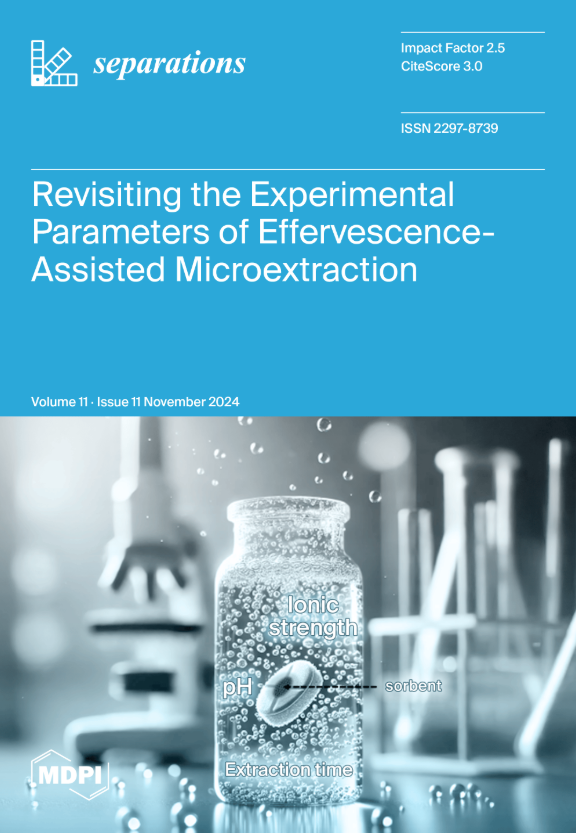烤后葡萄片的香气特征:Sorbara和Spergola品种在可持续酿酒生产中的比较研究
IF 2.5
4区 工程技术
Q3 CHEMISTRY, ANALYTICAL
引用次数: 2
摘要
本研究旨在比较不同温度(120、140、160、180、200和240°C)下Sorbara和Spergola葡萄藤剪枝的香气特征。葡萄藤剪枝的一个潜在应用是将其用作注入芯片,以增强和改善酒精饮料和醋的老化过程。芳香化合物赋予独特的风味,并有助于最终产品的复杂性。热重-质谱联用演化气分析(TGA-MS-EGA)确定了木材基体发生实质性变化的热步骤。采用固相微萃取-气相色谱-质谱联用(SPME-GC-MS)分析挥发性化合物。几个关键的挥发性化合物被确定,显示其浓度变化作为品种和烘焙温度的函数。呋喃衍生物,如糠醛和酚类化合物,如愈创木酚和香兰素,是两种主要的挥发性化合物,它们主要决定了180°C以上烤过的葡萄片的香气。在较低的烘焙温度下,一些醛,如己醛和萜烯,定义了样品的香气特征。通过重新利用废料,该应用程序为食品工业中具有环保意识的葡萄栽培和可持续实践提供了一条途径。本文章由计算机程序翻译,如有差异,请以英文原文为准。
Aroma Profile of Grapevine Chips after Roasting: A Comparative Study of Sorbara and Spergola Cultivars for More Sustainable Oenological Production
This study aimed to compare the aroma profiles of Sorbara and Spergola grapevine prunings roasted at different temperatures (120, 140, 160, 180, 200, and 240 °C). One potential application of grapevine prunings is their use as infusion chips to enhance and improve the aging processes of alcoholic beverages and vinegars. Aromatic compounds impart unique flavors and contribute to the complexity of the final products. Thermogravimetry–mass spectrometry coupled with evolved gas analysis (TGA-MS-EGA) was conducted to identify the thermal steps at which substantial changes occurred in the wood matrix. Solid-phase microextraction–gas chromatography–mass spectrometry (SPME-GC-MS) was used for the analysis of volatile compounds. Several key volatile compounds were identified, showing variations in their concentrations as a function of cultivar and roasting temperature. Furan derivatives, such as furfural, and phenolic compounds, such as guaiacol and vanillin, were the two main chemical classes of volatile compounds that predominantly defined the aroma of grapevine chips roasted above 180 °C. At lower roasting temperatures, some aldehydes, such as hexanal and terpenes, defined the aroma profiles of the samples. By repurposing waste materials, this application offers a pathway for environmentally conscious viticulture and sustainable practices within the food industry.
求助全文
通过发布文献求助,成功后即可免费获取论文全文。
去求助
来源期刊

Separations
Chemistry-Analytical Chemistry
CiteScore
3.00
自引率
15.40%
发文量
342
审稿时长
12 weeks
期刊介绍:
Separations (formerly Chromatography, ISSN 2227-9075, CODEN: CHROBV) provides an advanced forum for separation and purification science and technology in all areas of chemical, biological and physical science. It publishes reviews, regular research papers and communications. Our aim is to encourage scientists to publish their experimental and theoretical results in as much detail as possible. There is no restriction on the length of the papers. The full experimental details must be provided so that the results can be reproduced. There are, in addition, unique features of this journal:
Manuscripts regarding research proposals and research ideas will be particularly welcomed.
Electronic files and software regarding the full details of the calculation and experimental procedure, if unable to be published in a normal way, can be deposited as supplementary material.
Manuscripts concerning summaries and surveys on research cooperation and projects (that are funded by national governments) to give information for a broad field of users.
The scope of the journal includes but is not limited to:
Theory and methodology (theory of separation methods, sample preparation, instrumental and column developments, new separation methodologies, etc.)
Equipment and techniques, novel hyphenated analytical solutions (significantly extended by their combination with spectroscopic methods and in particular, mass spectrometry)
Novel analysis approaches and applications to solve analytical challenges which utilize chromatographic separations as a key step in the overall solution
Computational modelling of separations for the purpose of fundamental understanding and/or chromatographic optimization
 求助内容:
求助内容: 应助结果提醒方式:
应助结果提醒方式:


